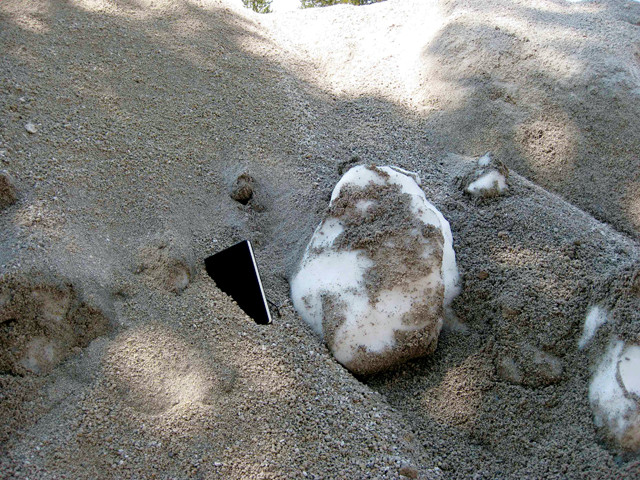
by U.S. Geological Survey Thursday, June 14, 2018
Robert D. Crangle Jr., mineral commodity specialist for the U.S. Geological Survey, compiled the following information on pumice, an essential commodity for the construction, horticulture and abrasives industries.

The rapid cooling of pumice results in a highly porous, low-density rock with excellent insulating properties. The photo above shows snow, on a hot August day, entrapped in pumice at an Oregon pumice production facility. Credit: Robert D. Crangle Jr.
Pumice is an extremely light, highly porous extrusive volcanic rock, formed through the rapid cooling of air-pocketed lava. In fact, some pumice is so light that it can float on water. Although pumice is often light in color as well, depending on its mineral makeup, it can vary from white to pink to gray to black. Fine-grained pumice, or pumicite, is made up of minute grains, flakes, threads or shards of volcanic glass that are finer than four millimeters. Pumicite and volcanic ash are descriptive terms and are often used interchangeably.
Because it is porous and lightweight, pumice is well-suited as an aggregate material in lightweight building blocks, which is its primary use both in the United States and abroad. Pumice performs especially well in European-style construction, because of its weight, strength and cement-like properties. In the United States, pumice is also used extensively in abrasive products (including pencil erasers, cosmetic exfoliants, and a variety of heavy-duty hand cleaners), horticulture (including landscaping) and denim stonewashing. Minor applications include its use as an absorbent, a concrete aggregate, a filter aid and a tire traction enhancer.
U.S. and global consumption of pumice is expected to decrease in 2009 due to the decline in the residential and commercial construction sectors, the major users of pumice- and pumicite-related products.
All pumice produced in the United States originates from open-pit mines in Arizona, California, Idaho, Kansas, Nevada, New Mexico and Oregon. Deposits are particularly plentiful in the West, but legal challenges and public land designations could limit access. Processing is typically limited to drying, crushing, screening or expanding, in which it is heated to a high temperature until its embedded air pockets rupture. This causes pumice to rapidly expand, much like popcorn. Expanded pumice is often used in specialized applications and may be sold at a significantly higher price than its crude counterpart.
For more information on pumice and other mineral resources, visit minerals.usgs.gov/minerals.
Greece and the United States lead the world in pumice production.
In 2008, 22 companies with 24 active mining operations in the United States produced 1.14 million metric tons of pumice.
U.S. apparent consumption of pumice between 2007 and 2008 decreased 7 percent to 1.21 million metric tons as a result of the slowing residential and commercial construction sectors.
Pumice and pumicite production is sensitive to mining and transportation costs, so higher fuel prices, which lead to increased production costs, could lead to imports or other materials becoming more attractive than domestic pumice.
Large pumice rafts can drift hundreds of kilometers, over several years, in oceanic currents.
Pumice is the preferred abrasive for the denim stonewashing industry.
Expanded pumice is used as a filtration medium for beer and vegetable oil.
A small percentage of pumice is used in pencil erasers, toothpaste, heavy-duty hand cleaners and cosmetic exfoliants, including Lava® soap.
Pumice is also often used in pet litter, diluents, engineered fill, filter aids, geotechnical aids and pottery clays.
The average value of pumice in 2008 was approximately $25 per kilogram.
© 2008-2021. All rights reserved. Any copying, redistribution or retransmission of any of the contents of this service without the expressed written permission of the American Geosciences Institute is expressly prohibited. Click here for all copyright requests.